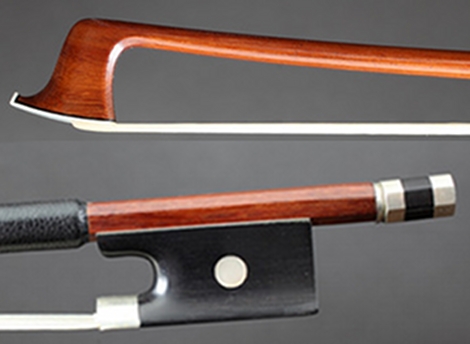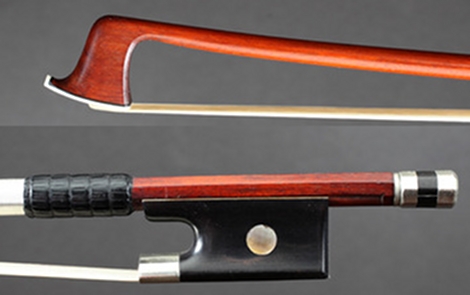CHARLES NICOLAS BAZIN; THE FOUNDER
"How can we speak of the man who is the source of so many of bows of such good quality, without once again evoking Mirecourt and its primordial importance for violinmaking and for French bowmaking?" J.F Raffin - "L'Archet"

As Raffin rightly says, it is not possible to talk of Charles Nicolas Bazin, without mentioning the importance of the school/workshop system in Mirecourt that introduced the French bowmaking to the world. But it is also true, that reversing the order of addends the result doesn't change, because Charles Nicolas Bazin "is" the school of bows" in Mirecourt.
Of course, he is not the only one who has contributed to create this school, you will remember that even Pajeot had trained some of the best generation of the bowmaking era : Fonclause, Maline, Maire, etc. The detail that distinguishes the work of the former from the latter , except for the levels involved, the artistic depth of Etienne Pajeot and Charles Nicolas Bazin, they are not even comparable, as already mentioned the first one is considered a genius similar to few others in our discipline, all lies in the design and organization of the workshop, about which we already started talking last week.
Son of Francois Xavier, he was born in Mirecourt on April 24, 1847, and unlike many of his colleagues, he has the privilege of going to school until the age of 12 years .
In 1859 he begins attending his father's workshop and becomes soon his main assistant. In 1865 his father died of cholera and Charles Nicolas has the whole workshop on his shoulders when he is only eighteen . For an initial period Claude Charles Nicolas Husson helps him , he is a good friend of his father, but in a short time he is able to walk alone.
On February 14, 1867 he marries his first cousin Jeanne Emilie Bazin and three of their children will continue their father's job. Gustave, as luthier, Charles Louis and Emile Joseph as bowmakers .
In the early 70's, he starts good business relations with J. Hell, for whom he builds mainly octagonal bows and with frog including a microphoto; using Vuillaume's method.
Business are good , the orders increase and so does the level of respectability and importance of Charles Nicolas. In 1875 he obtain to that the status of "Artisans d'Art" for violin and bowmakers is recognized by the War Ministry, cutting their military service from five to three years. Unfortunately, this law did not last long, from '75 to 79, but made him popular enough to get him elected in the city council.
Until 1893, his laboratory is in constant growth. Besides being a good craftsman and an excellent businessman, he was also a skilled teacher, who could induce to follow his styling ways without imposing them. That's why from his workshop the best hands of the time, such as the brothers Fetique, came out.
At the beginning of '900 Bazin's workshop is the bowmaking center in Mirecourt. In addition to producing bows , once can find any type of supplies: mother of pearl, horsehair, silver rings, ebony, etc.
Between 1901 and 1906, the working staff increases, the workers goes from twelve to seventeen and the laboratory is able to produce yearly from 2000 to 3000 good quality bows. As already mentioned, the wide workshop of Pajeot, turns into a factory with Bazin.
In these years is also working with the city council for the opening of a real school, but he will not succeed in it. Thibouville will establish it a little later .
In 1907 he retires and hand his business over to his son Charles Louis, even if he continues to have his own little corner of workbench where he will remain to handle bows strings until his death on December 6, 1915.
The style

Having started with his father, Charles Nicolas' first period is very influenced by the Peccatte school , dominated by very angular shapes. At a later period, the profiles of both head and throat, become very soft and more rounded.
The heads recall a lot the new taste of Voirin: they are slender and with the profile of the ridge dropped back.
The frog, not just those of Charles Nicolas Bazin, but the great majority of those produced in the second half of the nineteenth century, unfortunately do not own the grace and harmony of their predecessors.
The reason for such a large drop in style is to be found in the setting of the production While the head is relatively easy to copy, it is more complicated to do the same for the frog . When you begin your approach bowmaking, you can detect some things in the bows and those that can be perceived at the best, because they are simpler, are those about the head, while the frog is the penultimate, which you can decode, just before the button.
The frog is pure architecture. The size of the ring in relation to the higher support, the tens of lines that create, depending on how they are developed and not just the shape they own, the harmony of the throat, catch your eyes only after you have spent years observing bows , and if you were lucky enough to have a good teacher. The guys who worked for Bazin had good hands to work, but due to their young age and maybe for what they was taught, had a strong background but a poor refinement.
Same thing can be said for the buttons.
Charles Nicolas Bazin's purchasers :
ANGARD, AUDINOT in Paris, Paul BLANCHARD in Lyon, E. BOULANGEOT, Charles BRUGERE, CARESSA et FRANCAIS, G.A. CHANOT, COLLIN-MEZIN in Paris, COURVISIER, COURTIL, DARCHES in Bruxelles, DIENS, J.P. DITER, FALISSE, FOETISCH, G. FOURNIER, P. GAUTHIE in Toulouse, Joseph HELL, P. HELL a Lille, E. HENRY, J. LAMY, P. LORANGE in Lyon, PARISOT, Charles PECCATTE, SILVESTRE et MAUCOTEL, J. TOURNIER.
Workers hired by C.N. Bazin in 1901
BRIQUEL Victor, CARDOT Charles, DUMONT Auguste, FETIQUE Victor Francois, GILLET Georges, JOLY Charles Louis, MORIZOT Louis, PIERNOT Charles Emile, REMY Camille, REMY Emile, SCHWARTZ Paul, TOUSSAINT Auguste.
Workers hired by C.N. Bazin in 1906
BAZIN Louis, BRIQUEL J. Victor, BROUILLER Victor, CARDOT Charles, DUMONT Auguste, DUMONT Leonis, GILLET Georges, HENRY Alexandre, HUSSON Artur J., LOTTE Francois, LOTTE Rene Emile, MALINE Sigisbert, MORIZOT Louis, PIERNOT Charles Emile, REMY Camille, REMY Georges, SCHWARTZ Paul.
So long
Paolo
|
 
 |